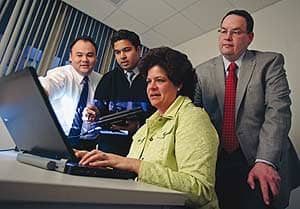 |
The renaming of 24×7‘s “Tech Talk” column to “Networking” is appropriate on many levels. “Tech Talk” has increasingly focused on the networking of medical devices and the networking of clinical engineering and information technology (IT) departments throughout health care. These areas are so broad and so important that 24×7 has assembled a cast of writers, each a leader in this collaboration, to highlight the many issues that CEs and biomedical managers will face in the coming months and years.
Clinical engineering leaders at Technology in Medicine Inc, Holliston, Mass, Stephen Grimes and Gordon Lawson have commented on some basic issues that face the independent clinical engineering department at its point of interface with IT.
Working relationships for the solution of interfacing and other system situations that can and do arise need to be addressed across two fronts. Strategic planning needs to be a part of any relationship with IT. The direct or tactical support of clinical device to network interfacing must deal with the emerging systems themselves, new and newly applied standards, deployment obstacles, and the establishment of operating relationships between clinical engineering and IT.
For example, if a service call indicates that a clinical documentation system is unable to pull information from a monitor, there are issues of first response, tracking of issues and progress, and the need to maintain communication among the user, clinical engineering, and IT. The overriding concerns when working with clinical systems are the good of the patient and the clinical needs of the caregiver. Therefore, the initial service provided on a system that includes medical devices should be by a qualified member of the clinical engineering service, working in concert with the caregiver or operator. Once it is decided that the call relates to connectivity, networking, or other information technology components, IT should be brought into the situation.
Experience has shown that approaching the IT department with a positive attitude based on mutual respect will usually yield positive results. Experience has also shown that CEs and BMETs are better positioned to troubleshoot and make a quick assessment than their IT counterparts, and that clinicians appear to work more harmoniously with the clinical engineering people.
 |
| Approaching the IT department with a positive attitude based on mutual respect will usually yield positive results. |
What Can I Access?
Another area of concern is the establishment of ground rules regarding IT personnel having access to clinical equipment and, conversely, for CE personnel having access to the network.
Qualified IT personnel need access to all areas that could impact mission critical information flow. However, changes in elements of the IT infrastructure such as network parameter setup (IP address, port assignments, network configuration details) that could impact patient areas, particularly life critical functions, should be communicated to clinical engineering in advance. This will assure that unintended consequences of otherwise innocent network modifications are avoided. In general, it is not necessary for IT to have access to medical equipment technical service modes, which in many cases include critical alarms, clinical decision parameters, etc, unless clinical engineering is involved firsthand.
Similarly, if service to be provided to a medical device that is attached to the information infrastructure could potentially affect that infrastructure, the IT department should be notified and concur that the action contemplated will not restrict data flow or damage the integrity of the IT system.
The present state of networked medical device development is one in which there are high degrees of variance from system to system with regard to issues of security, proprietary systems, and even deployment as self-contained networks, which may or may not be directly connected to the main IT system backbone. To effectively support many of these systems that cannot be managed with tools available to support other information technologies, clinical engineering typically requires a fairly broad level of access. However, in these situations, clinical engineering needs to have the appropriate IT skills and work closely with IT.
Organizing Service Calls
In dealing with service requests, it is important to the integrity of the process that there is a single point of contact for addressing all health care technology service and support issues. There should not be a separate point of contact for connected versus stand-alone devices. The most effective approach to a single point of contact, even where biomedical service is outsourced, is the on-site biomedical staff responding in person. Traditional IT-type help desks are not equipped to handle the myriad problems and situations that arise in the clinical environment, and in particular, are not prepared to deal with the clinical complexities that impact service strategies.
Auditable records are essential when a service call involves IT issues such as connectivity, compatibility, or interoperable systems. Just as CEs should involve their IT counterparts in the process, the computerized maintenance management system at clinical engineering should allow for the recording of IT work ticket numbers for cross-referencing purposes. This will allow for clearer communication regarding service progress, allow coordination of results and the closing of jobs that are completed, and provide a method to reconstruct the event at a later date.
Other areas of interface directly related to equipment support include the establishment of clear two-way communication between clinical engineering and IT regarding software, hardware, and environment changes, and managing security and security patches. Both groups must adopt and collaborate on the consistent application of standard practices designed to ensure that any service provided has minimal—and no unanticipated—effect on the organization’s ability to meet user needs. A key element of this process is the participation of both departments in regular change management meetings during which all anticipated changes, including hardware/application/software updates, network configurations, etc, are reviewed. Notification must be given and approval sought by clinical departments on all planned changes when those changes have any possibility of affecting patient care. All changes and updates should be documented and entered into the master equipment history file for future reference.
|
Read previous Networking articles from past issues of 24×7 by searching for Tech Talk in our online archives. |
 |
As a general statement, security patches fall under the same protocols as change management. Up-to-date records on operating systems, security patches, or any upgrades/updates should be maintained as part of the historical database as well as a unique listing of changes.
These issues represent the tip of an iceberg that looms large on the horizon of clinical engineering. Comments from you—our readers—are most welcome as we continue to frame the discussion of this most important paradigm shift in health care technology.
Raymond Peter Zambuto, CCE, FASHE, FHIMSS, FACCE, is president, Technology in Medicine Inc, Holliston, Mass, a Linc Facility Services Company, and is a member of 24×7‘s editorial advisory board. For more information, contact .





